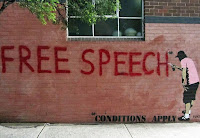 Here's one for the 1st amendment. Apple has been granted a patent named "Management, Replacement and Removal of Explicit Lyrics during Audio Playback" for technology that can automatically scan a song being streamed and edit out any swear words in the lyrics.
Here's one for the 1st amendment. Apple has been granted a patent named "Management, Replacement and Removal of Explicit Lyrics during Audio Playback" for technology that can automatically scan a song being streamed and edit out any swear words in the lyrics.
According to an article in Business Insider, the technology is different from automatic beeping of a swear word though. The system can detect an undesirable word then generate background music from the song in its place instead, so the transition is seamless.
Apple claims that the system may also work with books as well. For example, it could edit out words applying to sex or even full sex scenes from a book to make it more applicable to children.
Apple employs some censorship currently on Beats 1, limiting the content to anything without explicit lyrics. and the App Store has been notorious for keeping out porn or porn-related sites. That said, the list of "swear words" that the new technology works on will be undoubtedly controversial.
Apple hasn't said if it would actually employ the technology however, only that it's been granted the patent for it. If it's ever rolled out, it's bound to have free speech advocates everywhere up in arms.
(Photo Credit: Newtown Grafitti)
Apple claims that the system may also work with books as well. For example, it could edit out words applying to sex or even full sex scenes from a book to make it more applicable to children.
Apple employs some censorship currently on Beats 1, limiting the content to anything without explicit lyrics. and the App Store has been notorious for keeping out porn or porn-related sites. That said, the list of "swear words" that the new technology works on will be undoubtedly controversial.
Apple hasn't said if it would actually employ the technology however, only that it's been granted the patent for it. If it's ever rolled out, it's bound to have free speech advocates everywhere up in arms.
(Photo Credit: Newtown Grafitti)




